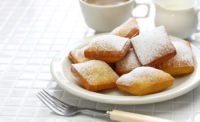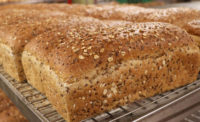The ancient allure of sourdough

As the artisan bread movement continues to gain momentum across the U.S., one of its most-ancient forms—sourdough—is garnering more-widespread attention.
Sourdough bread is through by the fermentation of dough using naturally occurring lactobacilli and yeast—organisms that exhibit a symbiotic relationship with each other in the presence of flour and warm water. Lactobacilli and wild yeast are responsible not only functional leavening, but also distinguishing flavor and aroma.
Sourdough starters are essential for Northern European 100 percent rye, where the sourdough’s lower pH helps bring the bread to sufficient life—and this application helped keep sourdough on the baking map through the years.
San Francisco has also played a significant role in fueling sourdough momentum. According to artisan sourdough lore, Basque miners during the 1850s California Gold Rush carried sourdough mother sponges in their packs to bake sourdough bread in camps across California’s Mother Lode country as they searched for the precious metal.
With an eye to opportunity, Isidore Boudin, who hailed from a family of master bakers in Burgundy, France, opened Boudin Bakery in San Francisco in 1849, commercializing sourdough. The legendary bakery has maintained continuous operation to the present day.
Thanks to Boudin Bakery’s success, it effectively typified the terroir of San Francisco sourdough—and Lactobacillus sanfranciscensis pays homage to these origins (even though L. sanfranciscensis also shows up in sour bread starters in countries like France, Germany and Italy … Japan also has a fondness for sourdough…). Sourdough eventually spread to across California, boosted by the artisan sourdough revival of the 1980s via other industry legends like Acme Bread Co. Sourdough styles have since spread across the U.S.
Bakery suppliers are also doing their part to promote sourdough. In 2013 Puratos launched its Sourdough Library in the Center for Bread Flavour research and innovation center located in St. Vith, Belgium. The library gathers and stores a collection of unique sourdoughs from around the world, preserving sourdough biodiversity.
Of course, the East Coast is also no stranger to the finer points of sourdough, and New Jersey bakery Hudson Bread—the subject of this month’s cover feature—has archived its trademark sour starters in the Puratos library (see our cover report for a video documenting this event).
Puratos has recorded more than 700 strains of wild yeast and 1,500 lactic bacteria to date.
While San Francisco first made sourdough famous in the U.S., it dates back to the earliest days of human history. The “Encyclopedia of Food Microbiology” even notes that a sourdough bread estimated to date back to 3700 BC was found during an excavation in Switzerland—and notes that the practice of sourdough fermentation likely goes back several thousand years earlier.
In terms of written history, sourdough’s earliest documented mention perhaps comes from Pliny the Elder in his tome, “Natural History,” published in 77 AD. In Chapter 26 on “The Various Kinds of Leaven,” the renowned Roman scholar discusses a “leaven which may be prepared with barley and water,” made into cakes, and shut closed into vessels “until they turn quite sour.” He says people often “make use of a little of the dough that has been kept from the day before.” He then goes on to note, “It is very evident that the principle which causes the dough to rise is of an acid nature, and it is equally evident that those persons who are dieted upon fermented bread are stronger in body.”
Today, sourdough fits neatly into the ongoing fermented foods trend while harkening back to its ancient roots.
I recently attended the opening of a new Puratos innovation center outside of Boston. During the proceedings, Daniel Malcorps, CEO of Puratos Group, emphasized, “The future of bread lies in its past.”
As the popular saying goes, “Everything old is new again.”
Looking for a reprint of this article?
From high-res PDFs to custom plaques, order your copy today!






